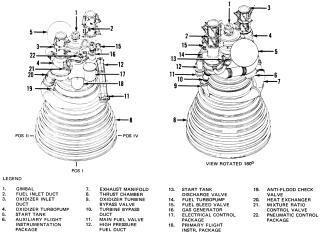J2 Engine
- Width : 6ft 8.5in (2.04m)
- Length : 11ft 1in (3.38m)
- Thrust(altitude) : 230,000lb (104.33ton)
- Rated run duration : 500sec.
- Manufacturer : North American Rockwell Corp., Rocketdyne Div. Canoga Park, Calif.


The J2 engine was fueled by liquid oxygen and liquid hydrogen,
5 group in the second stage(S-II), and one in the third stage(S-IVB) are/is used on Saturn V.
On the second stage(S-II), the center engine was fixed, and four other were mounted on the gimbal and performing attitude control of the rocket.
The engine on the third stage(S-IVB) was also mounted on the gimbal.
The gimbal was configured by compact and sturdy universal joint, and was a socket type bearing made of fiberglass and Teflon.
For directing a Apollo spacecraft to reach the Moon orbit, J2 engine has capability of re-ignited during flight.
In addition, the Space Launch System:the next generation of booster currently under development at NASA, improved J2X engine will be used.






Drawings
Related books and videos
-
Rocketdyne: Powering Humans into Space

AIAA Education November 30, 2005 USD39.95
No one had written an overall history of Rocketdyne - the professional historians said there was not enough preserved documentation for them to write a proper history book - so I determined to visit key survivors of the glory days of Rocketdyne to record their memories, add my own insight as a member of the team, and preserve the history of how large liquid propellant rocket engines evolved at Rocketdyne and why the team was so successful.
-
Stages to Saturn: A Technological History of the Apollo/Saturn Launch Vehicles

University Press of Florida September 19, 2003 USD39.95
A classic study of the moon rocket that launched the Apollo astronauts on their voyages of discovery."?Roger Launius, chief historian, National Air and Space Museum"This volume is just one of the many excellent histories produced by government and contract historians for the NASA History Office. . . . Roger Bilstein gracefully wends his way through a maze of technical documentation to reveal the important themes of this story. Rarely has such a nuts-and-bolts tale been so gracefully told.





